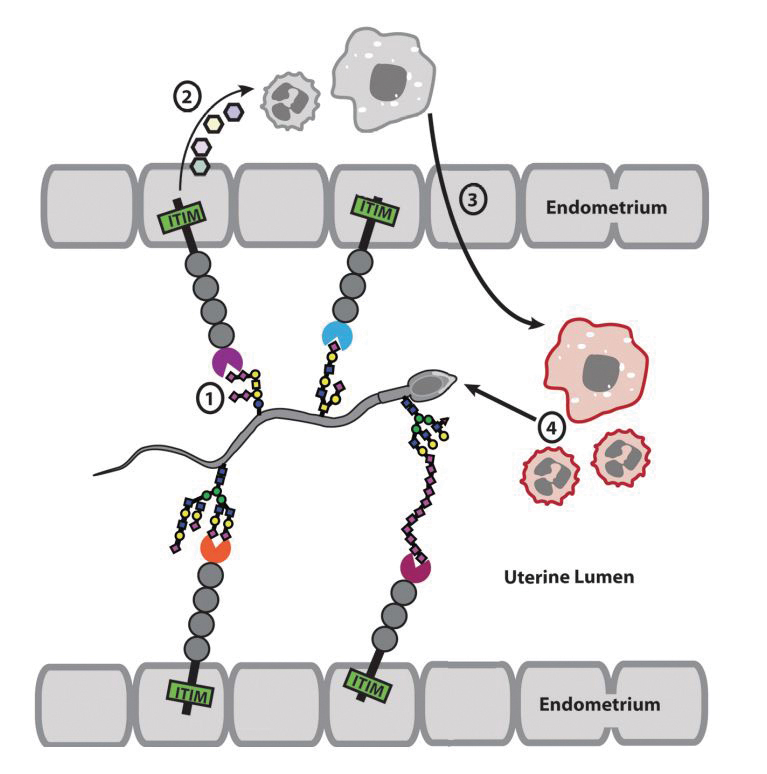Do sperm offer the uterus a secret handshake?
Why does it take 200 million sperm to fertilize a single egg?
One reason: When sperm arrive in the uterus, they are bombarded by the immune system. Perhaps, molecular anthropologist Pascal Gagneux says, many are needed so some will survive. On the other hand, the female may benefit by culling so many sperm.
“I’m a lonely zoologist in a medical school,” Gagneux said. “My elevator spiel is that all of life is one big compromise. (For an egg), being too easy to fertilize is bad; being too difficult to fertilize is also bad.”
Gagneux’s lab at the University of California, San Diego, has discovered the makings of something that might be compared to a secret handshake between sperm and the cells lining the uterus in mice and, perhaps, humans. Uterine cells, they report in the Journal of Biological Chemistry, express a receptor that recognizes a glycan molecule on the surface of sperm cells. This interaction might adjust the female’s immune response and help sperm make it through the leukocytic reaction.
.jpg)
The leukocytic reaction is not well understood. What we do know, Gagneux said, is that “after crossing the cervix, millions of sperm — a U.S. population worth of sperm — that arrive in the uterus are faced by a barrage of macrophages and neutrophils.”
This attack by the innate immune system kills most of the sperm cells in semen, winnowing hundreds of millions down to just a few hundred that enter the fallopian tubes. The defensive response may help prevent polyspermy, when an egg is fertilized by more than one sperm and cannot develop.
Sperm are coated in sialic acid–rich glycans, and the innate immune system uses sialic acid to differentiate human cells from invaders, so Gagneux and his lab expected that the glycan might interact with innate immune cells called neutrophils. But human neutrophils they tested were activated to a similar degree by sperm with and without sialic acid.
Meanwhile, the team noticed sialic acid–binding receptors called siglecs on endometrial cells. In solution, these endometrial receptors can bind to whole sperm. According to Gagneux, the binding interaction might help the sperm run the gantlet of the leukocytic response — for example, by dampening the immune response. Alternatively, it may be a way for uterine cells to weed out faulty sperm. In the immune system, siglecs help cells to recognize sialic acid molecules as markers of the body’s own cells, and in that context they can turn inflammation either up or down.
“It’s somewhat embarrassing how little we can say about what this (interaction) means,” Gagneux said. To understand its physiological significance, researchers first must look for direct interaction between sperm and intact uterine tissue — this paper looked at only sperm interacting with purified proteins and isolated cells.
It’s humbling to work in such a poorly understood area, Gagneux said. Reproduction “is a very, very delicate tug-of-war at many levels. The fact that there is (also) this immune game going on is completely fascinating.”
Enjoy reading ASBMB Today?
Become a member to receive the print edition four times a year and the digital edition monthly.
Learn moreGet the latest from ASBMB Today
Enter your email address, and we’ll send you a weekly email with recent articles, interviews and more.
Latest in Science
Science highlights or most popular articles

Mapping proteins, one side chain at a time
Roland Dunbrack Jr. will receive the ASBMB DeLano Award for Computational Biosciences at the ASBMB Annual Meeting, March 7–10, just outside of Washington, D.C.

Exploring the link between lipids and longevity
Meng Wang will present her work on metabolism and aging at the ASBMB Annual Meeting, March 7-10, just outside of Washington, D.C.

Defining a ‘crucial gatekeeper’ of lipid metabolism
George Carman receives the Herbert Tabor Research Award at the ASBMB Annual Meeting, March 7–10, just outside of Washington, D.C.

The science of staying strong
Muscles power every movement, but they also tell the story of aging itself. Scientists are uncovering how strength fades, why some species resist it and what lifestyle and molecular clues could help preserve muscle health for life.

Bacteriophage protein could make queso fresco safer
Researchers characterized the structure and function of PlyP100, a bacteriophage protein that shows promise as a food-safe antimicrobial for preventing Listeria monocytogenes growth in fresh cheeses.

Building the blueprint to block HIV
Wesley Sundquist will present his work on the HIV capsid and revolutionary drug, Lenacapavir, at the ASBMB Annual Meeting, March 7–10, in Maryland.

